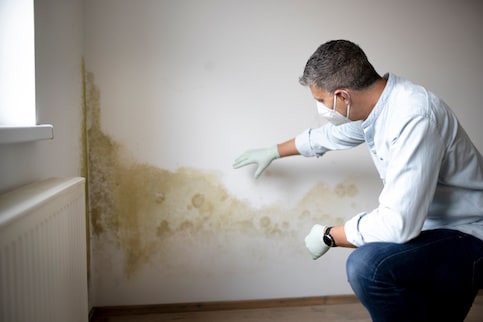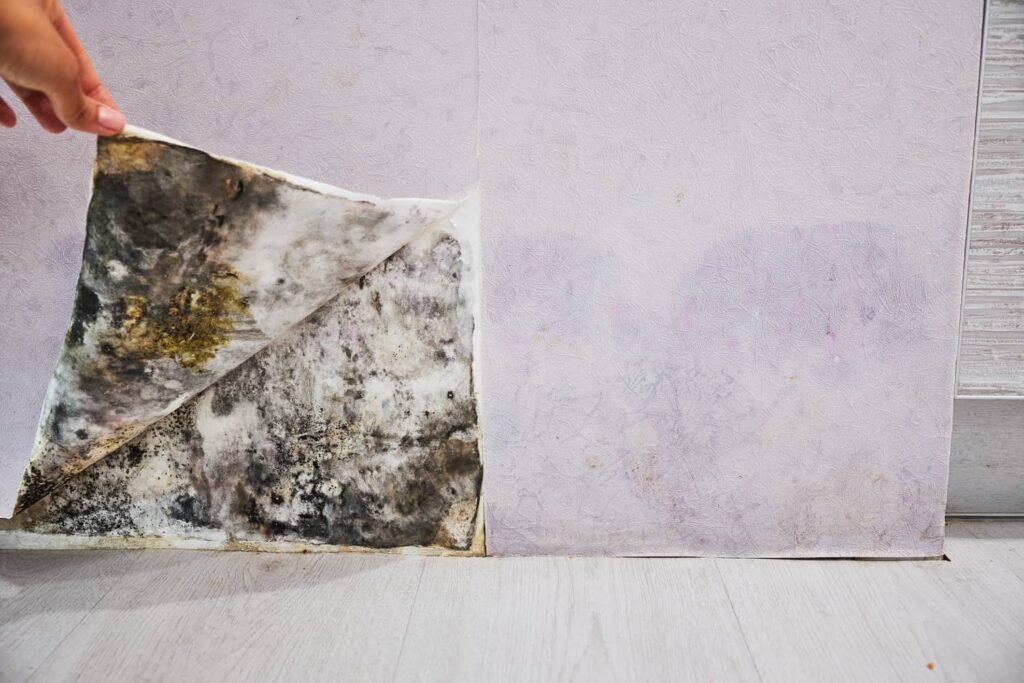Imagine this scenario: you’ve found your dream home, the one with the perfect location and the right number of bedrooms. But there’s one problem: mold. It’s a common issue that can be easily ignored or underestimated, but should you really turn a blind eye to it? In this article, we will explore the signs that indicate it’s time to walk away from a house with mold. From health risks to financial burdens, we will shed light on the importance of making an informed decision when it comes to dealing with this unwelcome visitor in your potential new home.

Signs of Mold in a House
Visible Mold Growth
One of the most obvious signs of mold in a house is the presence of visible mold growth. Mold usually appears as black, green, or brown patches on surfaces such as walls, ceilings, or floors. If you notice any discoloration or fuzzy spots, it could indicate the presence of mold. It’s important to remember that mold can also grow in hidden areas, such as behind walls or under carpets, so a thorough inspection is necessary.
Musty Odor
Another sign of mold in a house is a musty or earthy odor. Mold releases volatile organic compounds (VOCs) that create a distinct smell. If you notice a persistent musty odor, especially in areas with poor ventilation, it could be a sign of hidden mold growth. Pay attention to areas like basements, bathrooms, or damp crawl spaces.
Water Damage
Water damage is often a precursor to mold growth. If a house has a history of leaks, floods, or water intrusion, there is a higher likelihood of mold growth. Look for signs of water damage, such as water stains, peeling wallpaper or paint, or warped materials. Excess moisture provides the perfect environment for mold to thrive.
Allergic Reactions
If you or your family members experience unexplained allergic reactions or respiratory symptoms when you are in a specific house, it could be a sign of mold. Common allergic reactions to mold include sneezing, coughing, itchy or watery eyes, nasal congestion, and skin irritation. If these symptoms improve when you leave the house and worsen upon returning, it’s possible that mold is the culprit.
Dangers of Mold in a House
Respiratory Issues
Exposure to mold can lead to various respiratory issues. Mold spores can be inhaled and irritate the respiratory system, causing symptoms such as coughing, wheezing, shortness of breath, and chest tightness. Individuals with asthma or other respiratory conditions may experience more severe reactions. Prolonged exposure to mold can contribute to the development or worsening of respiratory conditions.
Allergic Reactions
Mold is a common allergen and can trigger allergic reactions in susceptible individuals. These reactions can range from mild to severe and may include symptoms like sneezing, runny nose, itchy eyes, and skin rashes. People with allergies or asthma are more likely to experience allergic reactions to mold. It is important to address mold issues to prevent ongoing allergic symptoms.
Weakened Immune System
Exposure to mold can weaken the immune system, making individuals more susceptible to infections and other illnesses. Mold releases toxins called mycotoxins, which can have immunosuppressive effects. This can make it harder for the body to fight off infections and could lead to a higher risk of respiratory infections, sinus infections, or fungal infections.

Determining the Extent of Mold Infestation
Visual Inspection
A visual inspection is the first step to determine the extent of mold infestation. Thoroughly examine all areas of the house, including hidden and hard-to-reach places. Look for visible mold growth, water stains, discoloration, or any signs of moisture or water damage. It is important to have good lighting and use tools like a flashlight and mirror to inspect hidden areas.
Mold Testing
If you suspect mold but cannot visually confirm its presence, mold testing can provide more conclusive evidence. There are different types of mold tests, including air sampling, surface sampling, or bulk sampling. These tests can identify the type of mold present, measure its concentration, and help determine the extent of the infestation. Consulting with a professional mold inspector can guide you in choosing the appropriate testing method.
Factors to Consider before Walking Away
Health Risks
Before making a decision to walk away from a house with mold, it is essential to consider the potential health risks. The presence of mold can aggravate allergies, respiratory conditions, and weaken the immune system. It is important to evaluate the health risks involved, particularly if you or your family members are susceptible to mold-related health issues.
Mold Remediation Cost
Mold remediation can be expensive, depending on the size of the affected area and the extent of the infestation. Consider the financial implications of mold removal and factor in the costs of hiring professionals, repairing damages, and preventing future mold growth. Compare the estimated costs of remediation with the overall value and condition of the house before making a decision.
Extent of Damage
Assess the extent of the damage caused by mold growth. If the mold is limited to a small area and has not caused significant structural damage, remediation may be feasible and cost-effective. However, if the mold has extensively spread throughout the house and has caused severe structural damage, it may be more practical to walk away and find a healthier living environment.

When to Walk Away
Extensive Mold Growth
If the mold growth is extensive and covers large areas of the house, it may be a clear sign to walk away. Extensive mold growth indicates a severe and potentially costly problem that may require extensive remediation measures. In such cases, the health risks and cost of remediation may outweigh the benefits of purchasing the property.
Presence of Toxic Mold
Certain types of mold, such as Stachybotrys chartarum (often referred to as black mold), produce mycotoxins that can be harmful to human health. If toxic mold is present in the house, it is crucial to prioritize your well-being and consider walking away, as the health risks associated with toxic mold exposure can be severe.
Structural Damage
If mold has caused significant structural damage to the house, it may be a red flag. Mold can deteriorate building materials, weaken the structural integrity, and compromise the safety of the property. If repairs and remediation measures are too extensive or costly, it may be wise to walk away and find a house in better condition.
When to Consider Mold Remediation
Limited Mold Growth
If the mold growth is limited to a small area and has not caused significant damage, remediation may be an option. Promptly addressing and treating small mold issues can prevent them from becoming larger problems. Consulting with a professional mold remediation specialist can help determine if the mold can be effectively removed without major renovations.
Minor Water Damage
If the mold growth stems from a minor water leak or damage that has been properly repaired, it may be possible to consider remediation. However, it is crucial to thoroughly address the source of the water damage and ensure that it has been completely resolved before proceeding with mold remediation. Failing to properly address the underlying moisture issue can lead to recurrent mold growth.
No Health Issues
If no members of your household have experienced any health issues related to mold exposure and the mold growth is minimal, you may choose to consider remediation. However, it is important to prioritize preventative measures to ensure that the mold does not reoccur in the future. Regular inspections, maintenance, and proper ventilation can help mitigate the risk of mold growth.

Mold Remediation Process
Hiring a Professional
Mold remediation is a complex process that often requires the expertise of professionals. Hiring a certified mold remediation specialist ensures that the job is done correctly and safely. These professionals have the necessary knowledge, experience, and equipment to effectively remove mold, prevent its spread, and address any underlying moisture issues.
Containment and Removal
The first step in mold remediation is establishing containment measures to prevent the spread of mold spores to unaffected areas of the house. This may involve sealing off affected areas, using negative air pressure, and implementing proper ventilation systems. The next step is the physical removal of mold-infested materials, such as drywall, carpeting, or insulation, using appropriate containment protocols to minimize the release of spores.
Cleaning and Disinfection
After the removal of mold-infested materials, thorough cleaning and disinfection of the affected areas are essential. Specialized cleaning agents and techniques are used to eliminate any remaining mold spores and prevent their regrowth. It is crucial to clean not only visible mold but also surrounding surfaces and objects that may have come into contact with mold spores.
Preventive Measures
To prevent future mold growth, it is essential to address any underlying moisture issues. This may involve repairing leaks, improving ventilation, or installing dehumidifiers in areas prone to excess moisture. Regular inspections and maintenance can help identify potential mold sources early on and allow for prompt action to prevent mold growth.
Cost of Mold Remediation
Factors Affecting Cost
Several factors can influence the cost of mold remediation. The size and severity of the mold infestation, the extent of structural damage, and the accessibility of the affected areas can impact the overall cost. Additionally, the type of mold present and the necessary remediation techniques may require specific equipment and materials, which can contribute to the overall cost.
Insurance Coverage
Depending on your insurance policy, mold remediation costs may be partially or fully covered. It is important to review your homeowner’s insurance policy to understand the extent of coverage for mold-related issues. Keep in mind that insurance coverage typically requires evidence of the cause of the mold growth and may have limitations or exclusions, so thorough documentation and professional assessments are crucial.

Legal Obligations
Seller’s Disclosure
Sellers have a legal obligation to disclose known mold issues to potential buyers. Depending on local regulations, sellers may be required to provide a written disclosure of any past or current mold problems. This allows buyers to make informed decisions and consider the potential costs and risks associated with mold remediation.
Tenant Rights
Tenants have rights when it comes to mold issues in rental properties. Landlords are generally responsible for maintaining the property in a habitable condition and addressing mold problems promptly. If mold growth poses health risks or violates local health codes, tenants can take legal action to ensure that the issue is resolved. Understanding your rights as a tenant is important in addressing mold-related concerns.
Preventing Mold Growth
Proper Ventilation
Proper ventilation is crucial in preventing mold growth. Ensure that all areas of the house, especially bathrooms, kitchens, and laundry rooms, are adequately ventilated. Use exhaust fans or open windows during and after activities that generate excess moisture, such as showering or cooking. Good airflow helps reduce humidity levels and prevent condensation, which can contribute to mold growth.
Moisture Control
Controlling moisture is key to preventing mold growth. Regularly inspect the house for any leaks, plumbing issues, or water intrusion. Repair any leaks promptly and address the underlying causes of water damage. Maintain appropriate humidity levels (around 30-50%) with the help of dehumidifiers in areas prone to high humidity. Dry wet areas or materials within 48 hours to prevent mold growth.
Regular Maintenance
Regular maintenance is essential in preventing mold growth. Keep the house clean and well-maintained, paying attention to areas prone to moisture, such as bathrooms and basements. Regularly inspect and clean air conditioning systems, gutters, and downspouts. Promptly address any signs of water damage or moisture issues to prevent mold from taking hold.
By understanding the signs of mold, the dangers it poses, and the necessary steps for remediation, you can make informed decisions when facing mold issues in a house. Whether it’s determining whether to walk away from a mold-infested property or considering the appropriate course of action for remediation, prioritize your health and consult with professionals for guidance. Remember, prevention is key in avoiding mold-related problems, so take proactive measures to control moisture and maintain a mold-free living environment.